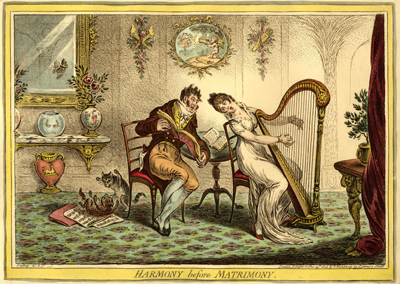Harmony Before Matrimony
This is the first of two contrasting prints with a distinctly musical theme showing a well-to-do couple before and after marriage. The contrast begins with the very different body language of the pair in the two prints. But it is mostly elaborated by the objects in the room, each of which provides a commentary on the couples' relationship.

© Trustees of the British Museum
As one would expect from the title of the first print, most of the details support the view of a harmonious couple very much in love. Reading from the same book of music titled "Duets de l'Amour" (Love Duets), the man is singing, the woman joining him while playing a harp. The two singers lean towards one another, their poses framing a book on the table behind them by the Latin poet "Ovid" whose best known poem was the Ars Amatoria (the Art of Love).
Above them we see a picture of Cupid, the God of erotic love surrounded by two wall decorations: one featuring Cupid's quiver and piercing arrows of desire; the other including the torch of Hymen, the controlled flame symbolic of married love. This being the age of chinoiserie, behind the man is a shelf with a chinese vase featuring a man playing an instrument for a woman with a parasol. The vase contains two appropriately intertwined roses. Next to it are two goldfish in a bowl swimming in perfect coordination to face one another.
But among all these elements of harmony, there are a few indications of potential discord that may anticipate the lovers' problems in Gillray's companion print. The Cupid in the picture above them is directing his aim at a pair of love birds billing and cooing on their bird house. But he is not using the traditional arrows from his quiver which lay behind him intact. Instead he is firing a blast from a blunderbuss. This may be Gillray's way of implying that both parties were love-struck at the same time or the overpowering nature of their desire. But a note of violence (and noise) has been introduced that runs counter to the perceived harmony of the rest of the scene. That note of violence is, perhaps, reinforced by the cats whose attitudes suggest an equal measure of play and sexual aggression.
Perhaps the two most tantalizing and telling details in the print are ones that have no simple precedent elsewhere that I am aware of. The first is the butterfly attracted by its own image in the mirror, which suggests a pursuit grounded in some degree of narcissism (the two lovers bear some resemblance to one another) and which may (like the image in the mirror) turn out to be both temporary and illusory. And finally, below the mirror, there is a heart shaped vessel with a sphinx, suggesting that the heart of another may be fundamentally inscrutable.
Gillray was, of course, not the first to create prints depicting love in several states. Hogarth created two versions of a couple before and after sexual intercourse, simply named Before and After (1736). And as Draper Hill mentions in his commentary on Matrimonial Harmonics, Hogarth's successor, John Collett, created a four plate series, Modern Love, (published 1782) showing the deterioration of a relationship from "Courtship," through "The Elopement" and "The Honey Moon" to "Discordant Matrimony."
But in both Hogarth and Collett, there is a strong element of moralism. Both members of Hogarth's couple are guilty of overturning The Practice of Piety for "Rochester's Poems" and salacious "Novels." Their relationship is never harmonious, but portrayed as a sexual power struggle. In Collett, the heroine of the piece is identified as "Miss Fanny Falsestep," and the hero is designing from the start and an unfaithful husband by the end.
Gillray's version, on the other hand, remains remarkably non-judgmental.
Sources and Reading
- Commentary from the British Museum on Harmony Before Matrimony.
- Draper Hill, The Satirical Etchings of James Gillray, 1976, #86.
- "Before and After (Hogarth)," Wikipedia
- "John Collett (artist)," Wikipedia
- Thomas Wright and R.H. Evans, Historical and Descriptive Account of the Caricatures of James Gillray #538.
- Thomas Wright and Joseph Grego, The Works of James Gillray, the Caricaturist; With the History of His Life and Times, pp. 324-5.
Comments & Corrections
NOTE: Comments and/or corrections are always appreciated. To make that easier, I have included a form below that you can use. I promise never to share any of the info provided without your express permission.